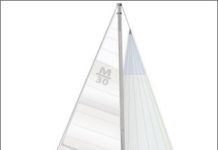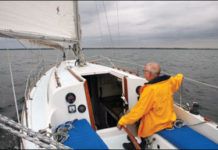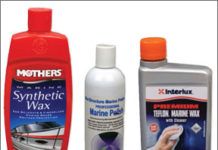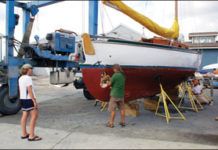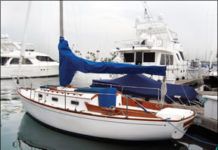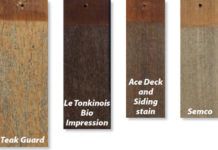Used Sailboat Review: Morgan 30
On the water, the Morgan 30 is a fine boat to look at, with springy sheer and an attractive stern. Although the boat has a full 6-foot, 2-inch headroom, the freeboard is low. This graceful form predates World War II and can be found in late Cruising Club of America-era boats. Our sea trials aboard reader Ray Mummerys Morgan 30 Wavedancer in South Floridas Biscayne Bay, offered proof of the boats impeccable balance. In 12 knots of breeze, with a 130-percent genoa, Wavedancer easily steered herself to windward, even holding a course as deep as 120-degrees relative wind angle, with no attention to the helm. Compared to modern 30-footers with canoe underbodies and fin keels, the boat is far from nimble. What the boat lacks in thrills, she makes up for with a seakindly ride.
Gripping Hitches for Loaded Lines
Testers evaluated five different knots to determine which would be the ideal for holding a tensioned line. Testers considered ease of tying and untying, ease of learning and recall, and holding power with various types of line. The old standard rolling hitch was pitted against the modified rolling hitch, icicle hitch, gripper hitch, and sailors hitch.
Charley Morgan’s Lovely Legacy
Fifty-two years ago, a mongrel yawl named Brisote was launched on the waters of Tampa Bay, setting in motion a chain of events as improbable as they are inspiring. The hard-chined hull form was the creation of local designer Charlie Hunt and a 28-year-old sailmaker named Charley Morgan. Evolving during midnight "tank tests" of small scale models on nearby Lake Wales, the hull cut through the water with little effort. But with its boxy cabin top and hard chine, the boat was hardly a work of art. In the rush to make the start of the 1957 St. Petersburg, Fla. to Havana Race, the masts, sails, and keel were scavenged from other boats. The race committee initially snubbed Brisote, contending it wasnt fit for a sailing race to Havana because it lacked an engine. The absurdity of banning a sailboat for being a sailboat prompted a few choice words from Morgan and the committee promptly retreated. The boat, true to its name, breezed to first in its class.
Paste Waxes Test Six-month Checkup
In February 2009, Practical Sailor tested a sampling of 10 paste waxes.After six months, two of these waxes clearly stood out for their continued ability to bead water and repel dirt. Collinite No. 885 Fleetwax and 3M Marine Ultra Performance Paste Wax retained the best gloss and water beading abilities. Mothers Cleaner and the Nu-Finish Paste performed well. Among the automative products that we included in the test, Turtle Wax F21, and Kit waxes stood out.
Practical Sailor Launches Long-term Liquid Boat Wax Test
With an ever-growing number of boat wax products on the market, Practical Sailor settles on 25 liquid wax products to test for application, initial gloss, and water beading. Marine wax manufacturers included Star brite, Cajun, Collinite, 3M, Mothers, Interlux, Rejex, Imar, Yacht Brite, West Marine, Turtle Wax, and Island Girl. In many ways the waxes all look, feel and smell the same and their differences may be in what the market application the manufacturers are seeking. Most of the two dozen waxes did a good job in the initial testing, and Practical Sailor will watch these for long-term protection. Waxes with a slightly oily wax finish formula showed better results at water beading in our initial tests, including two products by Star brite, and liquid waxes Island Girl, Zaino Brothers Z-3, Collinite Nos. 845/925, two carnauba wax products by Meguiars and Turtle Wax F-21.
Diesel Biocides Take On Contaminated Boat Fuel
Biological contamination of a fuel tank is a true challenge to any boater. Once the tank is infected with bacteria, an absolute cleansing of all contaminating organisms is necessary, or else the surviving organisms will repopulate the tank. Practical Sailor took a look at how fuel contamination occurs and tested six biocide fuel additives to combat a tank infected with microbial bacteria. Biobor JF, Racor, Stanadyne, Star brite, and ValvTect biocides were tested against diesel cultures shown to have a variety of bacterial and fungal species present. Similar to the effectiveness of antibiotics, the effectiveness of the biocides can varying depending on the type of infection they are fighting, testers found.
Do-It-Yourself Boatyards
The cost of buying and maintaining a sailboat has spiraled to an all-time high. There are a few steps sailors can take to help keep boating cost effective, including buying a sound older boat and finding a boatyard that is friendly to do-it-yourselfers. In an effort to support affordable boating, Practical Sailor has launched a reader survey on DIY yards, where boaters can rate their favorite boatyard on criteria such as protection from foul weather, boat hauling equipment, service quality and availability, Travelift operator skill, and yard ambiance. These are among the criteria PS Technical Editor Ralph Naranjo used to rate our sample DIY yard, Galesville Harbor Yacht Yard on Marylands western shore of the Chesapeake Bay. Our look at Galesville and some tips on choosing the best do-it-yourself yard offer valuable insight for the DIY boat owner looking for a place to haul out.
PS Advisor: Boat Buyers on the Prowl
Every so often, I find myself boat shopping and turn to the reviews in "Practical Boat Buying." I’m looking for a trailerable, 20- to 26-foot, easy to rig, singlehandable boat—and fast wouldn’t hurt either. I am a beginner, thinking about the Rhodes 22, Tanzer 22, O’Day 23, or Balboa 26. Did I mention I didn’t have a lot of money to spend?
Hobie Mirage i12s Inflatable Kayak
Alright, we know what youre thinking: A pedal boat in Practical Sailor? Thats what we thought, too, when Hobie sent us the Mirage i12s in response to our search for an inflatable kayak that could serve as a secondary tender for a cruising sailboat. The 12-foot PVC hull has overlapping glued and welded seams and a slick, abrasion-resistant bottom. The chambers are inflated to a modest 3 to 5 psi (compared to the 6.5 psi for the Walker Bay Airex reviewed in July 2008), which limits stiffness. For the tropics, PS prefers Hypalon to PVC, but that would add weight and push the price up. The hull carries a two-year warranty, not enough for an $1,800 boat (MSRP), in our opinion. Five years would be our minimum. The stern of the boat has bungee cords and an area for lashing down a dry bag, tackle box, or snorkel gear, but potential for provisioning runs is limited. A compartment in the bow will hold small items. To our chagrin, the space was too small to easily stow the hand pump. What sets this boat apart is the drive system. This is not your Camp Hiawatha paddle boat.
Six-Month Checkup: Long-Term Boat Wood Finish Exposure Test
Practical Sailor closes in on its search for the best teak oil, best marine varnish, and best synthetic wood finish this month. Testers check in on the 53 coated wood panels on our test rack, which have been enduring the elements for six months. Testers rated the panels for single-season gloss and color retention and coating integrity. The test products included dozens of one-part varnishes, two-part varnishes, synthetic wood finishes and stains, spar varnishes, wood sealants and teak oils from makers like Interlux, Pettit, Epifanes, Le Tonkinois, Minwax, Ace Hardware, Star brite, and West Marine. The long-term evaluation aims to find the best exterior wood finish based on overall ratings for ease of application, gloss integrity and appearance, and how the coating fares over time under real-world conditions. At the six-month mark, this report offers our single-season recommendations for finishing teak decks, cockpit trim, toerails, and other exterior wood surfaces.





































